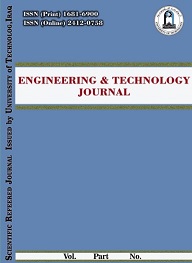Abstract
This work studies the protection from corrosion in the inner surface of petroleum storage tanks by applying nano-coating on the AISI1018 steel type used in these tanks. BNi-2 alloy, used as coating layer, was deposited using the DC sputtering technique to obtain protection layers of nano-coating. The cyclic potential dynamic polarization technique is used to study and evaluate the resistant metal to localize corrosion, for example, pitting and crevice corrosion. The samples were evaluated in a 3.5% NaCl aqueous solution using the polarization method to determine the corrosion rate. The input parameters of deposition included ion current 16 mA, vacuum 10-1 mbar, time of deposition was 60 minutes, and the distance between target and substrate was 2.5 cm. The surface roughness of the uncoated specimens was (0.1466 μm), and after coating, it decreased to (0.0933μm). The most important factor that affects the corrosion of the coated steel surface is the surface topography of steel before coating, as it is known that the spattering process coats the facing surface to target better than the inclined surface topography. Therefore, some micro scratches non-coated well worked as
nucleation for corrosion as detected in stereo microscope images for coated and
uncoated surfaces. By calculating the corrosion rate from cyclic potential
dynamic polarization for coated and uncoated workpieces, pitting and crevice
corrosion improved approximately ten times compared to the uncoated AISI1018
steel surface
nucleation for corrosion as detected in stereo microscope images for coated and
uncoated surfaces. By calculating the corrosion rate from cyclic potential
dynamic polarization for coated and uncoated workpieces, pitting and crevice
corrosion improved approximately ten times compared to the uncoated AISI1018
steel surface
Keywords
Nano coating AISI 1018 steel Corrosion test Petroleum storage tanks BNi-2
